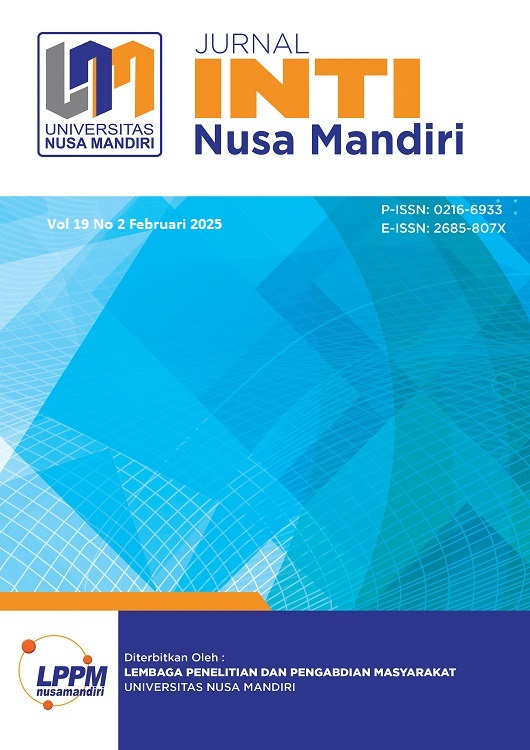IMPLEMENTASI METODE RAPID APPLICATION DEVELOPMENT DAN PENGUJIAN KATALON PADA APLIKASI LAPORAN BARANG RUSAK
DOI:
https://doi.org/10.33480/inti.v19i2.6113Keywords:
damage reporting, RAD, web-based applicationAbstract
The management of State-Owned Assets (BMN) within the Secretariat General of the National Resilience Council faces challenges in recording and reporting damaged assets. The current manual process leads to delays, data inaccuracies, and hinders effective asset maintenance. This study aims to design and develop the Labarus (Laporan Barang Rusak) application as a digital solution to support faster and more accurate recording and monitoring of damaged BMN assets. The Rapid Application Development (RAD) method was used to accelerate the application development process through an iterative approach that allows for prototyping and immediate validation by users. Application testing was conducted using Katalon to ensure functional compliance with requirements and compatibility across various devices. The outcome of this research is a web-based application that enables users to report damaged goods online, track the status of repairs, and automatically generate damage and repair reports. This application reduce recording errors, speed up the repair process, and support the ongoing digital transformation in Setjen Wantannas. This research contributes by developing a web-based application called LABARUS (Laporan Barang Rusak) to replace the slow and error-prone manual processes, thereby enhancing the efficiency and accuracy of asset management in the Setjen Wantannas.
Downloads
References
Afriansyah, R., Pratama, M. S., & Ventani, E. (2022). Pelatihan dan pembangunan sistem informasi manajemen pelaporan kerusakan sarana & prasarana dan pendataan aset di RSJ Provinsi Bangka Belitung. KACANEGARA Jurnal Pengabdian Pada Masyarakat, 6(1), 33. https://doi.org/10.28989/kacanegara.v6i1.1324
Ardi, F., & Putro, H. P. (2021). Pengujian Black Box Aplikasi Mobile Menggunakan Katalon Studio (Studi Kasus: ACC Partner PT. Astra Sedaya Finance). Jurnal Universitas Islam Indonesia, 2(1), 1–3.
Handayani, H., Faizah, K. U., Mutiara Ayulya, A., Rozan, M. F., Wulan, D., & Hamzah, M. L. (2023). Perancangan Sistem Informasi Inventory Barang Berbasis Web Menggunakan Metode Agile Software Development. Jurnal Testing Dan Implementasi Sistem Informasi, 1(1), 29–40.
Hazanah, E. K., Oktaviani, A., & Nurfalah, R. (2022). Penerapan Model Waterfall Dalam Perancangan Sistem Informasi Berbasis Web Pada Devan Petshop. Jurnal Responsif : Riset Sains Dan Informatika, 4(2), 135–141. https://doi.org/10.51977/jti.v4i2.613
Hidayat, N., & Hati, K. (2021). Penerapan Metode Rapid Application Development (RAD) dalam Rancang Bangun Sistem Informasi Rapor Online (SIRALINE). Jurnal Sistem Informasi, 10(1), 8–17.
Ibrahim, A., Arief, A., & Abdullah, S. Do. (2020). Keamanan Untuk Penerapan Layanan Publik Pada Sistem Pemerintahan Berbasis Elektronik (SPBE): Sebuah Kajian Pustaka Sistematis. IJIS - Indonesian Journal On Information System, 5(2), 135. https://doi.org/10.36549/ijis.v5i2.105
Kusyadi, I., Mulyati, S., Setiany, A. P., Noviyanto, D., & Aisah, S. (2022). Pengujian Aplikasi Kas Keuangan Menggunakan Katalon. Jurnal Teknologi Sistem Informasi Dan Aplikasi, 5(2), 91. https://doi.org/10.32493/jtsi.v5i2.16958
Prastyo, D., & Irawan, D. (2024). Rancang Bangun Aplikasi Inspeksi dan Checklist Terintegrasi menggunakan Metode Rapid Application Development (RAD). Bit-Tech, 7(1), 162–173. https://doi.org/10.32877/bt.v7i1.1603
Qomariah, L., & Sucipto, A. (2021). Sistem Infomasi Surat Perintah Tugas Menggunakan Pendekatan Web Engineering. Jurnal Teknologi Dan Sistem Informasi (JTSI), 2(1), 86–95. Retrieved from http://jim.teknokrat.ac.id/index.php/JTSI
Saputra, A. M. A., Kharisma, L. P. I., Rizal, A. A., Burhan, M. I., & Purnawati, N. W. (2023). TEKNOLOGI INFORMASI: Peranan TI Dalam Berbagai Bidang. Jambi: PT. Sonpedia Publishing Indonesia.
Saputri, S. D., Andrawina, L., & Supratman, N. A. (2021). Perancangan Sistem Informasi Manajemen Berbasis Web Pada Sua Coffee Menggunakan Metode Rapid Application Development. E-Proceeding of Engineering, 8(5), 8090–8101.
Sari, A. N. M.-2025/Ganjil/Bidang B.-A. T.-3666-1-10-20200806. pdfain. P., Haromainy, M. M. Al, & Purnomo, R. (2024). Implementasi Metode Rapid Application Development Pada Aplikasi Sistem Informasi Monitoring Santri Berbasis Website. Decode: Jurnal Pendidikan Teknologi Informasi, 4(1), 316–325. https://doi.org/10.51454/decode.v4i1.348
Siwu, B. H. M., Rampo, V. Y., & Joshua, S. R. (2022). Sistem Informasi Pelaporan Kerusakan Fasilitas Kantor Berbasis Web. Jurnal Teknik Informatika Dan Elektro, 4(2), 120–129. https://doi.org/10.55542/jurtie.v4i2.413
Suryanto, A., & Putra, R. P. (2020). Rancang Bangun Sistem Informasi Kearsipan Pada Bagian Kearsipan Dan Dokumentasi Mahkamah Agung Ri. INTI Nusa Mandiri, 15(1), 73–80. https://doi.org/10.33480/inti.v15i1.1441
Syahputra, E. R., & Sembiring, B. O. (2023). Sistem Informasi Laporan Kerusakan Barang Pada CV. Mekar Jaya Berbasis Web, 3, 3132–3140.
Yudahana, A., Riadi, I., & Elvina, A. (2023). Perancangan Sistem Informasi Pendaftaran Peserta Didik Baru (PPDB) Berbasis Web Menggunakan Metode Rapid Apllication Development (RAD). Rabit : Jurnal Teknologi Dan Sistem Informasi Univrab, 8(1), 47–58. https://doi.org/10.36341/rabit.v8i1.2977
Downloads
Published
How to Cite
Issue
Section
License
Copyright (c) 2025 Yayat Ruhiyat, Ridan Nurfalah

This work is licensed under a Creative Commons Attribution-NonCommercial 4.0 International License.
Penulis yang menerbitkan jurnal ini menyetujui ketentuan berikut:
1. Penulis memegang hak cipta dan memberikan hak jurnal mengenai publikasi pertama dengan karya yang dilisensikan secara bersamaan di bawah Creative Commons Attribution 4.0 International License. yang memungkinkan orang lain untuk berbagi karya dengan pengakuan atas karya penulis dan publikasi awal pada jurnal.
2. Penulis dapat memasukkan pengaturan kontrak tambahan yang terpisah untuk distribusi non-eksklusif dari versi jurnal yang diterbitkan (misalnya, mengirimkannya ke repositori institusional atau menerbitkannya dalam sebuah buku), dengan pengakuan atas publikasi awalnya pada Jurnal.
3. Penulis diizinkan dan didorong untuk memposting karya mereka secara online (misalnya, dalam penyimpanan institusional atau di situs web mereka) sebelum dan selama proses pengiriman, karena hal itu dapat menghasilkan pertukaran yang produktif, serta kutipan dari karya yang diterbitkan sebelumnya.











